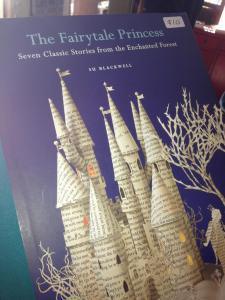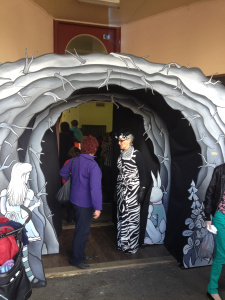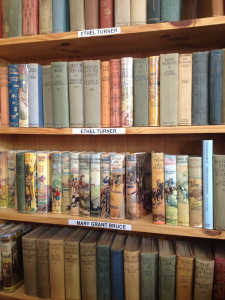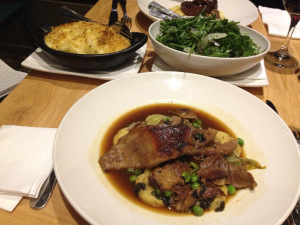Narrelle M. Harris's Blog, page 37
May 4, 2013
Clunes Booktown 2013
 After my first Clunes Booktown Festival in 2012, reliving the experience in 2013 seemed a terrific idea, particularly as this time I’d be in the company of horror writers Jason Nahrung and Kirstyn McDermott, who had recently moved to Ballarat.
After my first Clunes Booktown Festival in 2012, reliving the experience in 2013 seemed a terrific idea, particularly as this time I’d be in the company of horror writers Jason Nahrung and Kirstyn McDermott, who had recently moved to Ballarat.
So off on adventures I went, meeting Jason at Wendouree train station and joining him, Kirstyn and Kirstyn’s mum Cornelia on the pleasant drive to the little booktown that could.
We had not been in Clunes more than fifteen minutes when Kirstyn displayed her secret superpower for the first time. She finds the best, most wonderful, most excellent books in the store – no matter how overcrowded or disorganised the bookshop. No matter if there are three thousand dull books and the prize is buried at the back of the shop, under fourteen boxes and a sleeping elderly cat that bites all who come near. Kirstyn. Will. Find. The. Perfect. Book. She ended the day with four or five gems, but this was her first – a book of fairytales illustrated with photographed book art.
I am filled with envy. It’s a beautiful book.
But the day had its pleasures, even if Kirstyn pounced on all the gorgeous art books.
There was the lovely entry to the children’s areas, where readings took place on and off during the day.
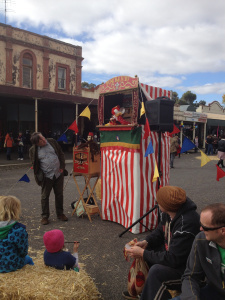 And old fashioned story telling in the form of a Punch and Judy show.
And old fashioned story telling in the form of a Punch and Judy show.
And the unintentionally hilarious buckets of ‘Women’s Books’. I’ve never really understood the use of that term. Is there a hit squad that comes after men who read any of these books? And why haven’t they been hunting me down for reading… not these books. They do present a lovely vision in pastel colours I suppose.
 Some attendees were not there for the books. Actually, a lot of people brought their dogs for the day. They must have all been bookish dogs, because they were very well behaved. So were most of the people, especially considering how very crowded the tents, shops and streets were.
Some attendees were not there for the books. Actually, a lot of people brought their dogs for the day. They must have all been bookish dogs, because they were very well behaved. So were most of the people, especially considering how very crowded the tents, shops and streets were.
One of my favourite little shops had shelves of books by Ethel Turner and Mary Grant Bruce, both staples of my childhood.
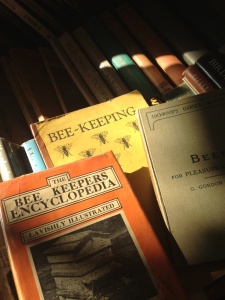 That shop also had a whole section on beekeeping, which naturally made me think of Sherlock Holmes as well.
That shop also had a whole section on beekeeping, which naturally made me think of Sherlock Holmes as well.
The festival this year covers even more ground than last year’s, with the basketball court behind the courthouse also filled with tents and literature. It’s fabulous but exhausting. After wandering around Clunes for several hours (and yes, I did find a book about music slang terms which I can use in my new rock-and-roll-saves-the-world-from-monsters project), we withdrew with aching feet and returned to Ballarat.
There I refreshed myself at the new Mitchell Harris Wine Bar. Besides stocking excellent local wines (including their own) and share plates, the rather cool venue has this beautiful art by street artist Vexta painted straight onto the distressed-industrial brickwork.
And from there, Tim and I dined perhaps a little too heartily at The Lane, which specialises in local produce. Above you see a lamb that died so that I might have deliciousness, and creamy, perfect cauliflower cheese that could have been a meal in itself. The Ballarat Wightwick Pinot Noir that accompanied my feasting went down rather well too.
Tomorrow I brave not the madding crowds of Day 2 of the Booktown Festival, but the knights errant (and possibly erroneous) of Ballarat’s newly reopened Kryal Castle. I hope to report soon on both jousting and a torture museum!
Visit the official Clunes Booktown site
Disclosure: Narrelle travelled to Ballarat and Clunes and dined out courtesy of Ballarat Regional Tourism.
Narrelle M Harris is a Melbourne-based writer. Find out more about her books, smartphone apps, public speaking and other activities at www.narrellemharris.com.


April 30, 2013
Review: Bread and Circuses by Felicity Dowker (AWW Challenge 2013 #7)
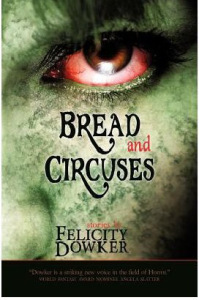 Felicity Dowker is the writer who made me see the potential of the zombie story. Previously, zombies had just been hulking, mindless brain-eaters, good as a metaphor for mindless mass threat (an analogy for overconsumption or the way humanity self-anaesthetises, or even the fear of Alzheimer’s) but not much more.
Felicity Dowker is the writer who made me see the potential of the zombie story. Previously, zombies had just been hulking, mindless brain-eaters, good as a metaphor for mindless mass threat (an analogy for overconsumption or the way humanity self-anaesthetises, or even the fear of Alzheimer’s) but not much more.
Then I read her short zombie love story, Bread and Circuses, and the whole genre changed for me.
I’ve read a lot of excellent zombie fiction since then, and tried my hand at a zombie story myself, but Bread and Circuses remains one of my favourites.
How good was it, then, that Ticonderoga Press scooped up this fabulous writer of horror (and winner of awards) to produce a collection – Bread and Circuses: stories by Felicity Dowker?
SO GOOD is the answer you are looking for.
This collection is replete, from start to finish, with tales full of rage, creeping horror and, almost surprisingly, the notion of love both as a destructive and a redemptive force. The eponymous Bread and Circuses and Jesse’s Gift most readily exemplify that particular theme, but elements of it arise in Red Delicious, To Wish on a Clockwork Heart and Us, After the House Came Back.
The settings for Dowker’s horror are often urban, revolving very much around the home, around children and relationships. Domestic violence features strongly as a theme, as does love and revenge. The whole is imbued with a sense of female power, as well as the consequences not only of abusing others but of willingly surrendering your autonomy (and therefore safety) to another.
Each story has its own voice too. While some names or notions may recur, there is great variety in the types of story being told. Some are drawn from fairy tales, others from mythology; yet others are very contemporary in their conception. Zombies and vampires are represented, as is the horror circus trope, but there are touches of steampunk, of traditional fantasy (dragons and wizards!) as well as urban myth and the great tradition of revenge tragedies.
Felicity Dowker is one of Australia’s best new voices in horror fiction, her powerful feminist approach giving the genre a good deal of…well, fresh blood. Be creeped out, disturbed, challenged and thoroughly (if sometimes unwillingly) captivated!
Buy Bread and Circuses from indiebooksonline
Get Bread and Circuses
 in paperback from Amazon.com
in paperback from Amazon.comListen to the short story Bread and Circuses as a podcast at Tales to Terrify
Narrelle M Harris is a Melbourne-based writer. Find out more about her books, smartphone apps, public speaking and other activities at www.narrellemharris.com.


April 25, 2013
Lost and Found 3: The Solo Rapture

When the Rapture came, only Henry Smithfield noticed. Everyone else was rather too busy just living their flawed lives.
Henry, a paragon of virtue in a tarnished world, heard trumpets and looked to the sky as he walked past the Federal Court of Australia on La Trobe Street. To his left was the court building, all imposing glass and concrete with its brightly coloured entryway, and the rather less glamorous concrete fountain. Over the road, to the right, was Flagstaff Gardens, filled with morning joggers, tai chi classes, city dwellers taking their city dogs for a run on the green.
To tell the truth, Henry was a little bit smug that he was the only one to hear the trumpets, to notice the call of the angelic host. He thought it more than a little ironic, too, that the call had come while he was part way between the halls of justice on one side and a former cemetery on the other. The final judgement was coming at just the right time and place.
Henry stopped in the street, stood on the edge of the non-functioning fountain (nobody seemed to have cared enough to turn it back on again after the easing of a decade of water restrictions) and held his hands to the sky. Waiting.
The heavenly host played a few more notes and then paused, allowing stragglers to catch up. But no-one else heard. No-one else stopped to look towards the heavens. Well, one or two people, but they were mainly checking for potential rainclouds. This was Melbourne. You could never entirely trust the forecast.
A few people paused to cast a curious glance at Henry, but he wasn’t hurting anyone and besides, the daft bugger in his jeans and hoodie and dark sneakers looked beatific more than dangerous. Perhaps his case had been found in his favour, they thought. One jogger gave him two thumbs up and a congratulatory grin on the way past.
The heavenly host gave a little sigh, looked at their sole audience member, shrugged and figured that maybe Facebook hadn’t really been the best way to send invitations to this particular party. Still, there was no need to blame Henry the Pure for being the only one with manners enough to notice the call.
With a beat of their wings, the host created one hell of a downdraft, which collected Henry and then drew him up. It was a bit startling at first, and Henry kicked his feet, trying instinctively to stand on solid ground. His shoes fell into the puddle of water lying on the base of the defunct fountain. He waggled his socked feet a little, then decided it was quite pleasant, this flying business. Grinning, he let himself be lifted.
Nobody noticed.
So, Henry got to heaven and found himself the sole occupant of a rather more dull than expected paradise.
The remaining inhabitants of the earth mainly didn’t notice that Judgement Day had been and gone, and went on being the embodiment of good and evil, heaven and hell, god and the devil, in their own personal way, sometimes in the very same person, as they’d done ever since they’d been given the gift of choice.
Only one person ever missed Henry, and that was his sister, who had loved her brother but frankly found him so impossibly perfect that she rarely saw him. His perfection made her feel inadequate, whereas most of the time she felt she wasn’t such a bad old stick, really. She was kind to animals and the elderly and bought the Big Issue and tried to be supportive and to be a good friend. As human beings go, she really was a lovely person. Not perfect by any means, but she made an effort. If heaven had been a little less rigid in its spiritual dress code, she might have heard the call.
But rigid it was, and most people are flawed, and really, the vagaries of heaven and hell had never really had that much impact on daily life on earth, the in-between place where devils and angels were part of the same clay that made everyone else.
In the end, the heavenly host withdrew entirely from earthly affairs, and valiantly tried to hide their disappointment from Henry that Judgement Day had been such a fizzer. Words were definitely going to be had with the marketing people.
And the world? It went on, being good, bad and indifferent, depending on the predelictions of its individual inhabitants, as it always did.
Lost and Found is and irregular series of posts about random items I find abandoned on the streets. Sometimes I’ll make up stories about them.
Narrelle M Harris is a Melbourne-based writer. Find out more about her books, smartphone apps, public speaking and other activities at www.narrellemharris.com.


April 23, 2013
Love is an action
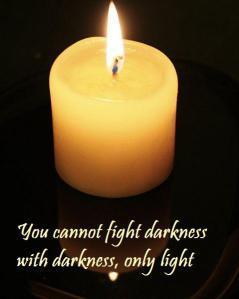
Candle image from Wikipedia Commons; picture by Richard W.M. Jones
I think of myself as a sort of realistic optimist. I mean, I’m not a complete Pollyanna, thinking that everything will be just fine if you just think positively about it for long enough. Life is complex, pain is real and bad people do exist, after all. But I do think that most people are fairly decent, and that good exists in the world along with the bad.
However, I do think that, collectively and individually, the best ‘good’ happens when we do something to make it happen. We have a lot of entropy to fight against and, to paraphrase the quote, the only thing needed for evil to flourish is for good people to do nothing.
I saw a few things recently that got me thinking about this idea – of ‘good’ being the outcome of active choices.
One is a post that I saw on a social media site. The original post was a note that said: They say you die twice. One time when you stop breathing and a second time, a bit later on, when somebody says your name for the last time.
The comments were filled with anxiety and distress about being lost to time, but I don’t think memory and identity need to be the same thing. I think you can have an influence in the world long after your name is forgotten.
Despite my , I honestly think that my name is unimportant compared to the effect I might have on the people I love and the world in which I live. All of us may go on in the world in ways we never anticipated.
After you’re dead, you may not have a name, but a kind word you had for someone, a selfless deed you performed, a word of encouragement you gave or the grace you had to truly listen to someone… those actions in turn can inspire kindness, good deeds, encouragement and grace in others, and so those good things are handed on and on and on. Maybe someone in your nameless future will be stronger and happier because once, even once, you took the time to care, and that act was paid forward.
The second instance was a friend’s Facebook update stating that she was tired of feeling depressed, angry, disenfranchised and essentially powerless in the face of persistent inequalities and injustices in Australian politics, society, and the world in general. She decided that she would try to focus more on the principle of ‘be the change you want to see in the world’.
The truth is that if we decide it’s all too hard and too horrible and irredeemably awful, and turn our backs, nothing will change.
It’s only when we become engaged that we have a hope of influencing things. Maybe as an individual you can’t change the big picture – but we can act within our spheres of influence, and that can become collective. We can be advocates for the issues that matter to us and encourage others to participate in making a noise – and if we keep it up, making a change as well.
Hell, we can just engage with the people around us to be open, encouraging and supportive. Maybe we can’t change the whole world, but we can make one person’s world better than it was yesterday. We can make the time to listen, to say a kind word, do a good deed, make one choice to be the kind of person we want to see.
After all, love is not just something we feel. It’s not just a state. It’s a verb, it’s something we do as well as feel, or it should be.
And thinking about all of these things, I ended up writing something. Well, a song, to be exact.
For context about the song: in the last year I’ve been playing around with writing lyrics. I’m working on a multimedia project which involves a story about a rock band saving the world from monsters, and as a natural progression, I’ve been writing the material that they’ll sing in the book. However, I last played piano regularly around 30 years ago, so I essentially don’t play an instrument. I’m no great shakes as a singer either, but I come up with melodies so that the lyrics work as lyrics and not as a poem (they are two quite different disciplines).
For the book project, I’ve been working with my niece, Jessica Harris, since she is a proper musician, to turn lyrics into songs. This one, however, is all my own work. The melody is pretty simple
Which is all by way of saying, I wrote a song about choosing to be actively engaged in the world, even though it can be downright painful at times, and I’ve written a melody for it, which may be a bit simplistic because I’m not a proper musician. But for what it’s worth, here it is.
If you’re game, here’s an MP3 of me singing this, a-capella.
Battlecry
They say love is hearts and honey
It’s what we feel
We gaze at each other and we sigh
At the altar of Eros, oh we kneel
But love is not a state we are in
Love is not a wailing violin
Love is an action, it is a force
Love is a battlecry
Shout it until you’re hoarse
This is the world I love
I will fight for it
For wisdom and kindness
I will fight for it
Open my arms to the blood and the pain
And I will do it again and again and again
You cannot fight darkness with darkness, only light
The other side of fear is love and the end of night
For every act that is cruel, there is one that is kind
For everyone lost, there is someone to find
For every dark deed, there is one of grace
For the hope of all this, I will take my place
This is the world I love
I will fight for it
Compassion and courage
I will fight for it
And open my arms to the blood and the pain
Open my heart again and again and again
Love is an action, it is a force
Love is a battlecry
Shout it until you’re hoarse
You cannot fight darkness with darkness, only light
The other side of fear is love and the end of night
For every dark deed, there is one of grace
For the hope of all this, I will take my place
Love is an action, it is a force
Love is a battlecry
Shout it until you’re hoarse
Narrelle M Harris is a Melbourne-based writer. Find out more about her books, smartphone apps, public speaking and other activities at www.narrellemharris.com.


April 21, 2013
The Year’s Best Australian Fantasy and Horror 2012
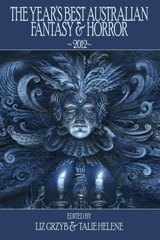 I am so excited and pleased to announce that I have a story in Ticonderoga Publications’ upcoming The Year’s Best Australian Fantasy and Horror 2012, edited by Liz Grzyb and Talie Helene.
I am so excited and pleased to announce that I have a story in Ticonderoga Publications’ upcoming The Year’s Best Australian Fantasy and Horror 2012, edited by Liz Grzyb and Talie Helene.
Stalemate, first published in my collection Showtime by Twelfth Planet Press, will appear alongside some of Australia and New Zealand”s very best writers of horror and fantasy. The collection contains 34 stories and poems:
Joanne Anderton, “Tied To The Waste”, Tales Of Talisman
R.J.Astruc, “The Cook of Pearl House, A Malay Sailor by the Name of Maurice”, Dark Edifice 2
Lee Battersby, “Comfort Ghost”, Andromeda Spaceways Inflight Magazine 56
Alan Baxter, “Tiny Lives”, Daily Science Fiction
Jenny Blackford, “A Moveable Feast”, Bloodstones
Eddy Burger, “The Witch’s Wardrobe”, Dark Edifice 3
Isobelle Carmody, “The Stone Witch”, Under My Hat
Jay Caselberg, “Beautiful”, The Washington Pastime
Stephen Dedman, “The Fall”, Exotic Gothic 4, Postscripts
Felicity Dowker, “To Wish On A Clockwork Heart”, Bread And Circuses
Terry Dowling, “Nightside Eye”, Cemetary Dance
Tom Dullemond, “Population Management”, Danse Macabre
Thoraiya Dyer, “Sleeping Beauty”, Epilogue
Will Elliot, “Hungry Man”, The Apex Book Of World SF
Jason Fischer, “Pigroot Flat”, Midnight Echo 8
Dirk Flinthart, “The Bull In Winter”, Bloodstones
Lisa L. Hannett, “Sweet Subtleties”, Clarkesworld
Lisa L. Hannett & Angela Slatter, “Bella Beaufort Goes To War”, Midnight And Moonshine
Narrelle M Harris, “Stalemate”, Showtime
Kathleen Jennings, “Kindling”, Light Touch Paper, Stand Clear
Gary Kemble, “Saturday Night at the Milkbar”, Midnight Echo 7
Margo Lanagan, “Crow And Caper, Caper And Crow”, Under My Hat
Martin Livings, “You Ain’t Heard Nothing Yet”, Living With The Dead
Penelope Love, “A Small Bad Thing”, Bloodstones
Andrew J. McKiernan, “Torch Song”, From Stage Door Shadows
Karen Maric, “Anvil Of The Sun”, Aurealis
Faith Mudge, “Oracle’s Tower”, To Spin A Darker Stair
Nicole Murphy, “The Black Star Killer”, Damnation And Dames
Jason Nahrung, “The Last Boat To Eden”, Surviving The End
Tansy Rayner Roberts, “What Books Survive”, Epilogue
Angela Slatter, “Jimmy Dean, Jimmy Dean”, This Is Horror Webzine
Anna Tambour, “The Dog Who Wished He’d Never Heard Of Lovecraft”, Lovecraft Zine
Kyla Ward, “The Loquacious Cadaver”, The Lion And The Aardvark: Aesop’s Modern Fables
Kaaron Warren, “River Of Memory”, Zombies Vs. Robots
Look at my name right there, surrounded by the likes of Isobelle Carmody, Alan Baxter, Stephen Dedman, Margo Lanagan, Jason Nahrung, Tansy Rayner Roberts and Felicty Dowker. Just look! I’m in a book with Kaaron Warren, people! And Terry Dowling! And all those fine, fine writers! LOOK! (Can you tell I’m excited, and proud, and pleased as punch? Can you?)
Alongside these stories, The Year’s Best Australian Fantasy and Horror 2012 will contain a 2012 round-up and a list of recommended reading.
The book is due out in July in hardback, paperback and ebook editions, and you can pre-order it at Indiebooks Online.
And so, in conclusion: SQUEEEEEEEEEEEEEEEEEE!
Narrelle M Harris is a Melbourne-based writer. Find out more about her books, smartphone apps, public speaking and other activities at www.narrellemharris.com.


April 17, 2013
Walking Shadows nominated for a 2012 Chronos Award!
 This week I learned that Walking Shadows was nominated for a Chronos Award in the Best Long Fiction category. I’m obviously chuffed to bits, especially as the nominations are sent in by members of Melbourne’s Continuum convention. Thank you Continuum People!
This week I learned that Walking Shadows was nominated for a Chronos Award in the Best Long Fiction category. I’m obviously chuffed to bits, especially as the nominations are sent in by members of Melbourne’s Continuum convention. Thank you Continuum People!
The Chronos Awards, according to the award site, “recognise excellence in Science Fiction, Fantasy and Horror by Victorians”. It’s particularly nice to be included in the short list for an award for Victorian creators at a Melbourne convention – and with a book that is set so firmly in my chosen home town.
I’m also very proud to be sharing nomination in that category with great writers like Jason Nahrung, Paul Collins and Felicity Dowker and fabulous editors Liz Grzyb and Talie Helene for their Year’s Best Australian Fantasy and Horror collection. Whatever the results of the award, it’s fabulous to be in such excellent company, in this and the other categories as well.
The Chronos Awards are very handsome too: sort of steampunky. (Here is a photo of Kirstyn McDermott’s 2011 award for Madigan Mine, which is another terrific book.)
Whether or not you’re going to Continuum or intend to vote in the Chronos Awards, have a look at the nominations and sample some of the great work being done by Victorian-based writers, artists, editors and bloggers, including:
Dark Matter Fanzine
SF Commentary
Viewing Clutter, (George Ivanoff’s DVD and Blu-ray reviews blog)
Bread and Circuses by Felicity Dowker (Ticonderoga Publications)
Salvage
 by Jason Nahrung (Twelfth Planet Press)
by Jason Nahrung (Twelfth Planet Press)Walking Shadows
 by Narrelle M. Harris (Clan Destine Press)
by Narrelle M. Harris (Clan Destine Press)Year’s Best Australian Fantasy & Horror 2011 edited by Liz Grzyb and Talie Helene (Ticonderoga Publications)
Dyson’s Drop (The Maximus Black Files)
 by Paul Collins (Ford Street Publishing)
by Paul Collins (Ford Street Publishing)Light Touch Paper Stand Clear
 edited by Edwina Harvey and Simon Petrie (Peggy Bright Books)
edited by Edwina Harvey and Simon Petrie (Peggy Bright Books)Epilogue
 (FableCroft Publishing)
(FableCroft Publishing)If you’re a member of the convention, you can vote in the Chronos Awards before 20 May 2013. If you’re not a member of the convention, you can join up! I’ll be on several panels, including a short version of my Writing Sex and Intimacy workshop (strictly for the over 18s). And if you can’t get to the con but would like to vote, you can get a voting membership for $5.
Visit the Chronos Awards page for all the details!
Narrelle M Harris is a Melbourne-based writer. Find out more about her books, smartphone apps, public speaking and other activities at www.narrellemharris.com.


April 14, 2013
Review: Cyanide and Poppies by Carolyn Morwood (AWW Challenge 2013 #6)
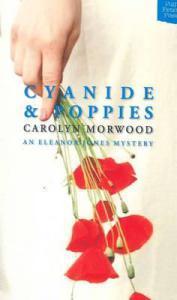 I read Carolyn Morwood’s Death and the Spanish Lady last year (and Gary the vampire and his librarian friend Lissa reviewed it), being a sucker for books set in my hometown, especially historical crime novels. That book was set in 1919, just after the Great War and during the devastating period of the Spanish flu epidemic. This story, set five years later, occurs on the eve of the police strike of 1923, which saw rioting in the Melbourne’s main streets.
I read Carolyn Morwood’s Death and the Spanish Lady last year (and Gary the vampire and his librarian friend Lissa reviewed it), being a sucker for books set in my hometown, especially historical crime novels. That book was set in 1919, just after the Great War and during the devastating period of the Spanish flu epidemic. This story, set five years later, occurs on the eve of the police strike of 1923, which saw rioting in the Melbourne’s main streets.
The maxim that you should start in the midst of the action is taken to heart in Cyanide and Poppies, with the heroine, former nurse Eleanor Jones, kneeling by the body of a dead man in the offices of The Argus newspaper, where she is now a journalist, while waiting for the police to arrive. It’s perhaps a mite too abrupt as a beginning, but it certainly throws the reader into the midst of the business, both with Edward Bain’s murder and the difficulties of a police investigation while a strike is in place.
It also catches us up with Eleanor very quickly, including her change of profession and the ways in which her experiences in the war still haunt her. Her shell-shocked brother Andrew is still struggling with the return to life and Eleanor herself is still determined to deny and kill off her feelings for her unfortunately married friend Nicholas.
Much of the plot unfolds in a strangely muted fashion, reflecting Eleanor’s (and Andrew’s) own disconnectedness from things. The rest of the world intrudes on them, of course – sometimes in immediate and violent ways – but there is a sense of them both viewing the event around them at arm’s length.
But the mystery gathers momentum, including Andrew’s relationship with the vivacious but scandalous medium, Nadine Carrides, and Eleanor’s concerns and doubts about Carrides as well as her colleagues at The Argus. As it does so, there is a sense that the siblings’ lives are also gaining in momentum and purpose, and light begins to break on both the crime and their own relationships and engagement with their post-war world.
The book is elegantly written, with well-crafted characters and a wonderful capacity to evoke the Melbourne of the era. It’s always a pleasure to recognise parts of my town in a book, and even moreso to get a feel for those places in other times and atmospheres.
Cyanide and Poppies has a slow build to a satisfying finale that cracks open light and air on lives as well as mysteries, and that’s a pretty fine thing.
Get Cyanide and Poppies in paperback
Get Cyanide and Poppies for Kindle and Book.ish
Read Gary and Lissa’s review of Death and the Spanish Lady
Visit Carolyn Morwood’s website.
Narrelle M Harris is a Melbourne-based writer. Find out more about her books, smartphone apps, public speaking and other activities at www.narrellemharris.com.


Review: Cyanide and Poppies by Carolyn Morwood (AWW Challenge 2013 #5)
 I read Carolyn Morwood’s Death and the Spanish Lady last year (and Gary the vampire and his librarian friend Lissa reviewed it), being a sucker for books set in my hometown, especially historical crime novels. That book was set in 1919, just after the Great War and during the devastating period of the Spanish flu epidemic. This story, set five years later, occurs on the eve of the police strike of 1923, which saw rioting in the Melbourne’s main streets.
I read Carolyn Morwood’s Death and the Spanish Lady last year (and Gary the vampire and his librarian friend Lissa reviewed it), being a sucker for books set in my hometown, especially historical crime novels. That book was set in 1919, just after the Great War and during the devastating period of the Spanish flu epidemic. This story, set five years later, occurs on the eve of the police strike of 1923, which saw rioting in the Melbourne’s main streets.
The maxim that you should start in the midst of the action is taken to heart in Cyanide and Poppies, with the heroine, former nurse Eleanor Jones, kneeling by the body of a dead man in the offices of The Argus newspaper, where she is now a journalist, while waiting for the police to arrive. It’s perhaps a mite too abrupt as a beginning, but it certainly throws the reader into the midst of the business, both with Edward Bain’s murder and the difficulties of a police investigation while a strike is in place.
It also catches us up with Eleanor very quickly, including her change of profession and the ways in which her experiences in the war still haunt her. Her shell-shocked brother Andrew is still struggling with the return to life and Eleanor herself is still determined to deny and kill off her feelings for her unfortunately married friend Nicholas.
Much of the plot unfolds in a strangely muted fashion, reflecting Eleanor’s (and Andrew’s) own disconnectedness from things. The rest of the world intrudes on them, of course – sometimes in immediate and violent ways – but there is a sense of them both viewing the event around them at arm’s length.
But the mystery gathers momentum, including Andrew’s relationship with the vivacious but scandalous medium, Nadine Carrides, and Eleanor’s concerns and doubts about Carrides as well as her colleagues at The Argus. As it does so, there is a sense that the siblings’ lives are also gaining in momentum and purpose, and light begins to break on both the crime and their own relationships and engagement with their post-war world.
The book is elegantly written, with well-crafted characters and a wonderful capacity to evoke the Melbourne of the era. It’s always a pleasure to recognise parts of my town in a book, and even moreso to get a feel for those places in other times and atmospheres.
Cyanide and Poppies has a slow build to a satisfying finale that cracks open light and air on lives as well as mysteries, and that’s a pretty fine thing.
Get Cyanide and Poppies in paperback
Get Cyanide and Poppies for Kindle and Book.ish
Read Gary and Lissa’s review of Death and the Spanish Lady
Visit Carolyn Morwood’s website.
Narrelle M Harris is a Melbourne-based writer. Find out more about her books, smartphone apps, public speaking and other activities at www.narrellemharris.com.


April 11, 2013
Review: Lawrence Leung’s Part Time Detective Agency
 Lawrence Leung has built his considerable reputation on two key ingredients: a kind of nerdy adorableness and a passion for investigation that isn’t half as guileless as it looks.
Lawrence Leung has built his considerable reputation on two key ingredients: a kind of nerdy adorableness and a passion for investigation that isn’t half as guileless as it looks.
From his early shows like Sucker, in which he spun a conman’s yarn with astonishing believability, through to his TV series Unbelievable, Leung has combined personable comedy with the search for underlying truths – often while toying with perceptions of reality. It makes his productions hugely enjoyable with a delightful frisson of uncertainty.
Of course, having previously admitted on these pages how fond I am of Sherlock Holmes, Leung’s latest show – Lawrence Leung’s Part Time Detective Agency – was always going to be on my list of Shows To See at the 2013 Melbourne International Comedy Festival.
Leung’s fast-paced show is full of energy and geeky charm. He opens by demonstrating the expertise at his disposal for running a (part time) detective agency, from his earliest forays into uncovering great conspiracies when he was at primary school through to offering observations and plausible deductions on the reasons for differences in kissing in different countries.
A huge key to the success of this show is his live demonstration of his deductive abilities, when he chooses two members of the audience and uses a series of simple questions and his acute knowledge of body language to determine which of them is lying. The demonstration means that the whole evening is predicated on Leung’s authentic credentials as a detective. Like Sherlock Holmes himself, Lawrence Leung, the part time detective, does not rely on gadgets and scientific mumbo jumbo – he relies on brilliant mental work and the demonstrable accuracy of close observation.
Leung’s skill and knowledge are provably real, and convinced of this, the audience eagerly joins in with his investigation of an old mystery – the true culprit behind a prank perpetrated on him at one memorable birthday party.
There are plenty of Sherlockian references, as well as other nods to geek culture while keeping it inclusive and friendly. You can’t help but like him, and to willingly join him in trying to solve this most mysterious of puzzles.
I won’t go into details – spoilers, sweetie – but I can say that Leung is not merely likeable, not merely adorkable – he is smart and genuinely clever. He is also (and being a comedy festival this is the clincher) very, very funny.
See Lawrence Leung’s Part Time Detective Agency at The Swiss Club, 89 Flinders Lane, Melbourne, during the comedy festival until 21 April 2013. ($24.50 to $29.50) Get your tickets online.
(The video on the booking site showing Leung inviting BBC’s Sherlock Holmes to the festival is a treat in itself!)
Other Holmesian links
Read about the things I’ve learned from Sherlock Holmes.
Read a GaryView of the Granada series episode The Sussex Vampire
Narrelle M Harris is a Melbourne-based writer. Find out more about her books, smartphone apps, public speaking and other activities at www.narrellemharris.com.


March 28, 2013
Interview: Tansy Rayner Roberts
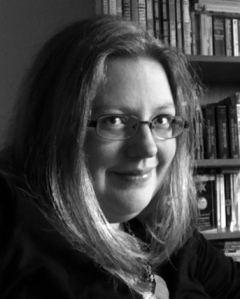 Tansy Rayner Roberts is a fantasy novelist who shares a pair of typing fingers with crime novelist Livia Day. Livia’s first murder mystery, A Trifle Dead, will be released from Twelfth Planet Press on 28 March 2013.
Tansy Rayner Roberts is a fantasy novelist who shares a pair of typing fingers with crime novelist Livia Day. Livia’s first murder mystery, A Trifle Dead, will be released from Twelfth Planet Press on 28 March 2013.
Tansy’s recent releases include Power and Majesty, The Shattered City and Reign of Beasts, the three books of the Creature Court trilogy. Her first novel, Splashdance Silver, was recently re-issued as an e-book.
With so much going on for Tansy and her alter ego, I thought it was high time I asked her a few searching questions. She repaid me with very thorough answers!
The Shattered City is a terrific book, telling a whole story yet still functioning as the middle book of a trilogy. You said to me you’d set a challenge to yourself to overcome the ‘Middle novel problem’. How do you define that problem, and how did you go about meeting it?
I think there are two sides to the middle novel problem – one is that narrative: the middle act in a three act structure is the one that has to hold everything together, and in the case of epic fantasy, that’s a really long time to keep everyone entertained while you move all the pieces into place for the big finale. What you don’t want is your reader to think of the middle book as being the interval they had to sit through in order to reach the second half.
The second and perhaps more dramatic problem is one of reader perception – fantasy readers are pretty worn down and cynical these days, and the middle novel of a fantasy trilogy has acquired a poor reputation, I think unfairly. If the middle novel is soggy or boring or has characters running around in circles for no good reason, then that’s the fault of the author and to some extent the trilogy – it doesn’t mean that middle books everywhere are unnecessary!
I rather like the middle book of a trilogy because it tends to be the one with the most character development, and more room to breathe because the readers know who everyone is now, and aren’t yet all tensed and psyched up for everyone to start being killed off. Which means, of course, that as an author, I can happily screw with their expectations.
In my own case, the secret was in fact to originally plan a four book series, agree to let it be a trilogy instead, and write two books worth of plot into the middle book. This meant paring down a lot of stuff, building up new characters, and sadly resisting the urge to kill off a beloved character as a cliffhanger to a volume. In retrospect, it meant that the middle volume had to be the tightest, and work the hardest, which is actually what I should have been striving for anyway.
After all that, though, Sarah Rees Brennan’s definition of the trilogy is one I now wave at people who suggest middle books are a waste of time. “Book 1 – Set up. Book 2 – Make Out. Book 3 – Defeat Evil.
 If you’ll pardon the pun, the concept of Velody being a dressmaker is interwoven through the whole of the Creature Court stories. It’s not just her job, it’s fundamental to who she is and her approach to life, and that sense of creating new things permeates the politics and relationships we see. It is also, though, a catalyst for some pretty destructive plot elements. I suppose I’m asking if you’re a dressmaker and, either way, how that concept got woven into plotting the series.
If you’ll pardon the pun, the concept of Velody being a dressmaker is interwoven through the whole of the Creature Court stories. It’s not just her job, it’s fundamental to who she is and her approach to life, and that sense of creating new things permeates the politics and relationships we see. It is also, though, a catalyst for some pretty destructive plot elements. I suppose I’m asking if you’re a dressmaker and, either way, how that concept got woven into plotting the series.
I’m so not a dressmaker!
I love fabrics and textile arts, and I’ve always been fascinated by them. I’m a quilter and I love to play with the pretties. But my secret downfall is measuring. I sew like I cook (and like I write!) – madly, and without measure. Which means trying to make an actual garment that fits an actual specific shape is totally beyond me.
I have however spent my life surrounded by artists and creative people, and I am well aware that whatever your artistic obsession is, that’s how you see the world. So it was important to me that Velody’s Point of View voice would be wrapped up in her sewing terminology. I did need a friend to read the books over for clanger mistakes, though – and among other things, to make sure Velody could do what she actually needed to be capable of doing, I did shift the industrial level of the world just a tad, to let her have an early Singer sewing machine.
I knew Velody was a dressmaker before I knew what her name was, so it is an integral part of the story, but the most important thing to me was that she was a professional craftswoman, someone who was a practical producer of things, because of the conflict between that life and the insanely frivolous, beautifully dressed Creature Court. Sure, they save the world on a regular basis, but that’s their only contribution to society – in other ways, they’re quite parasitic.
Velody had to have a real job, because one of the essential questions of the book was – how can you save the world and hold down a real job at the same time? I wanted a woman as protagonist who had responsibilities, and valued what she did in the daylight, and had to weigh that up with what she could achieve during the battles of the nox. Not all superheroes are Batman – some have to pay the rent! And the contrast between Velody and Ashiol, who drops every responsibility he’s ever been given, never hurts for money, and constantly lets the people he loves down, because of that single justification that he’s busy saving the world.
Heroing is so often unpaid work in fantasy worlds, to the point where heroes who want to be paid are seen as unworthy of the role, and I wanted to write a fantasy which addressed how problematic that is from a privilege/class/gender point of view. Not that I’m preachy about it, I hope!
Frankly, one of the questions I want to ask is: “How do you manage to be so very, very awesome as a plotter?” but that’s a rubbish question. I still want to ask it, though. Do you do huge, 10,000 word story treatments, like PG Wodehouse used to do with his own convoluted plots? What is the secret of your success?
Thank you for the compliment! I work really hard on my plots, it’s not a magical talent that comes naturally to me. I tend to work fairly free form, with only a general idea where I am going, but a quite clear idea where I want to end up. Mostly I allow my plots to grow out of characters rather than the other way around, because I find characters more interesting.
I also try and stop and check in from time to time, to make sure I’m going in the right direction, and to run the story so far past other eyes to make sure I’m not majorly stuffing up.
I did call upon a spreadsheet or two for this one, but that was mostly to keep track of character history rather than plot threads – there’s a complex back story and the hierarchy of the Creature Court meant I had to know the history of servitude and alliance that each character had been through – the fact that Mars was Livilla’s courtesi once and is now her equal and ally is important to how they behave towards each other, as is the uncomfortable, complex relationship between Ashiol, Garnet and Poet (which you’ll see more of in the third book!). There are a couple of characters not alive for the entirety of the trilogy who are vital to how my sweeties interact with each other now.
But as for plotting forward… I’m actually a terrible leaper rather than a looker. I know the feel of what I’m going for, and I grope wildly towards it. More than once, I get it wrong, and have to recover fast.
I will admit that when I was writing the third book, I was still building the finale, and in many cases I only knew about particular events days or hours before writing them. Other parts had been planned out from the beginning. But I am a big believer in the idea that if you know the past of your characters in great detail, then their future will unfold with integrity.
Do you have any preferences for a fantasy casting of the novels? I like Johnny Depp for Poet, myself.
I want to say he’s too old, but Johnny Depp, of course, is never too old. You’d definitely need someone with his great capacity for being weird, scary and innocent all at the same time. I have a fondness for the actor who played young Octavian in HBO’s Rome series – I think he could pull off the part, in a few years, which is at least as long as it would take to get something like this off the ground as a production. If not, grab him from a few years ago via. time travel and he can do the flashback scenes.
After seeing all those beautiful stills of the Great Gatsby, I would accept Carey Mulligan as Delphine in a heartbeat. Joel Edgerton or Dan Spielman as Macready. Now I’m just totally rifling through old Secret Life of Us casting…
Nicholas Hoult is too pretty for nearly everything he is in, so I’m sure we could find room for him somewhere.
When it comes to my central protagonists, though, Ashiol and Velody, I can’t cast them at all. I know how they look in my head, but couldn’t match them to anyone real.
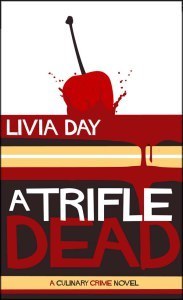 Your new crime novel, A Trifle Dead, comes out through Twelfth Planet Press later this month, under the pen name Livia Day. It’s set in Hobart and features a pastry chef named Tabitha Darling. Is this a kind of theme of yours? Elevating domestic skills to literary greatness? What is it about the domestic arts you find so appealing?
Your new crime novel, A Trifle Dead, comes out through Twelfth Planet Press later this month, under the pen name Livia Day. It’s set in Hobart and features a pastry chef named Tabitha Darling. Is this a kind of theme of yours? Elevating domestic skills to literary greatness? What is it about the domestic arts you find so appealing?
Partly it’s a fantasy for me – I will never cook as well as Tabitha nor sew as well as Velody. But I do value the domestic arts highly. The combination of practicality with aesthetic pleasure is fascinating – there’s a narrative there, and it’s something I find excellent to make stories out of. Tabitha doesn’t just cook – she uses food to soothe people, and butter them up, and tease them. She even withholds food on some occasions, which proves she is a little bit evil.
I wanted to show what a good detective she would make through her other life – and her other life is about social skills and food. You learn a lot from Tabitha about her work and her attention to detail – that’s there in how she dresses, as well, and organises parties, and is the social centre of her friendships.
But I also think that the domestic arts are not valued as highly as they should be in our society, particularly in our history. There’s that whole bullshit gender idea that something women do is lesser somehow, that it’s compromised, despite the fact that female artists often have less to work with from a resources point of view. As a social historian, I think it’s brilliant that women have often used domestic arts as a foil or a cover for other freedoms.
For instance the whole thing about patchwork being invented out of frugality and the saving of every scrap of fabric, is an insanely beautiful con job that the women of colonial America played on their men – sure, fabric was scarce, but it’s ridiculous to believe that the beautiful quilts they made were the most efficient use of their time. They used the cover of frugality and housewifely virtue to gather in female social groups, to share information and gossip, to entertain each other, and to make beautiful art that also had a significant social value as well as practical use.
And maybe that’s not true at all. Maybe that’s my immense Western 21st century ignorant privilege speaking, that I even think that. But the narrative seems so clear to me – a combination of pretty things and practical function can’t help but tell a story.
Also, my heroines are always more stylish than me. That’s definitely a theme.
This book is set in Hobart: what about Hobart makes it an appealing locale for the story?
Pretty much that I know Hobart inside and out, plus that’s where Tabitha lives, which makes it convenient. It was never a conscious choice.
Having said that, if I had been going out of my way to pick a location for a murder mystery that was going to be on trend in 2013, Hobart would have been a genius choice. Our media is exploding right now with the artistic and tourist boom in Tasmania, and it’s a very creatively exciting place right now.
We’ve been a forgotten corner of the country for a long time, off on our little island, but over the last few years, Tasmania has become a Destination with a capital D. When I first started writing about Tabitha and her world, I remember an earlier version of the manuscript being rejected by an industry professional who couldn’t comprehend my Tasmania at all – she had visited the place once I guess, and was so wrapped up in the narrative of us as a ghostly colonial throwback, all old fashioned sweet shops and “an almost biting sense of cold” that she could not accept a book which showed Hobart as being vibrant and bright and, you know, occasionally had a bit of sunshine.
AS I WRITE THIS WE ARE IN A HEAT WAVE BY THE WAY.
So yes, it’s rather lovely that the Australian narrative about Tasmania has changed and continues to change, just in time for this book to be released. Because the idea that books can’t be set here without being full of sad people and grey skies makes me want to beat my head on a sandstone brick.
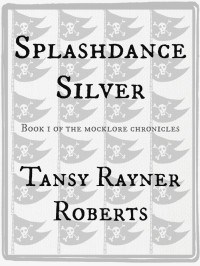 Your first novel, Splashdance Silver, has just been reprinted. How do you feel you’ve developed as a writer since you won the George Turner Prize with that book? Do you have any advice for your younger self? Does your younger self have any advice for your current self?
Your first novel, Splashdance Silver, has just been reprinted. How do you feel you’ve developed as a writer since you won the George Turner Prize with that book? Do you have any advice for your younger self? Does your younger self have any advice for your current self?
Fifteen years, can you believe it? My first novel was published nearly fifteen years ago (the anniversary is in September this year).
I know that I’ve developed a lot as a writer since then because I have had the charming and alarming experience of proofing the books for e-release (Splashdance is available now at Wizards Tower, Weightless Books and via Kindle, the rest are to follow shortly). Aargh! I also learned that my publisher really had stopped caring about me by book 2 because oh my goodness, the errors that made it through to the printed version, they make my head hurt…
My advice to my younger self would simply be not to get ahead of yourself. Selling those books was a brilliant moment of my writing career, but it was not the gateway to a consistent or easy career and there were a few painful bumps and jolts along the way. Then again, if I’d told my younger self that it would be another decade before she had another year of Real Full Time Income from writing, then it probably wouldn’t have good consequences for either of us!
I would like to tell her to get more manuscripts under her belt before having children because OMG what did you do with your time before then?
I’m not sure if that younger self has much useful to offer me in return (though I would totally take any free babysitting she’s offering) but I’m glad her books are back in print. Every now and then I get an email, or meet someone who genuinely loved those books and it’s so nice to hear because I have a tendency to put down my early work, and I shouldn’t. You have to own your history, all of it, and those books were a really important stepping stone for me.
Coming back to them, I still love the characters and the world, even if I would write them differently now. It’s quite fun to think back to where I was when I wrote them, and what I was bouncing off. It’s not until the third book (written more recently) that it really felt like they were MINE, though, rather than that faraway twenty-year-old
What’s coming up next for Tansy and/or Livia?
Livia has to finish the second Cafe La Femme book and get it to the publishers by May, which is exciting. I do love me a deadline. Tansy, meanwhile, is writing a lot of shorter pieces right now, while gearing up for the Next Big Fantasy Series. I have stories due to appear in anthologies such as One Small Step (Fablecroft), Where Thy Dark Eye Glances: Queering Edgar Allan Poe (Lethe Press) and Glitter and Mayhem. I’m also working on a bunch of non fiction commissions and will be announcing a new online creative writing course later in the year.
Plus, WORLD FANTASY OMG! I’m going to Brighton in October, and ridiculously excited about it.
**
Check out Tansy’s blog at http://tansyrr.com/, and follow her on Twitter as @tansyrr. You can hear her talking about the publishing industry on the Galactic Suburbia podcast, and about Doctor Who on the Verity! podcast.
Get A Trifle Dead by Livia Day, available from 28 March, from Twelfth Planet Press
Get Splashdance Silver by Tansy Rayner Roberts for Kindle or Weightless Books
Get Power and Majesty, The Shattered City and Reign of Beasts and other books by Tansy Rayner Roberts on Amazon.com
Narrelle M Harris is a Melbourne-based writer. Find out more about her books, smartphone apps, public speaking and other activities at www.narrellemharris.com.



